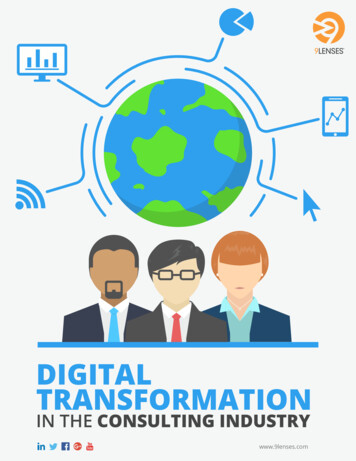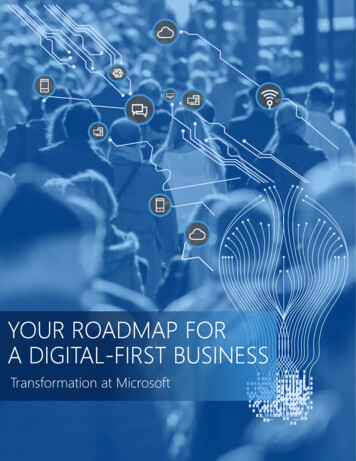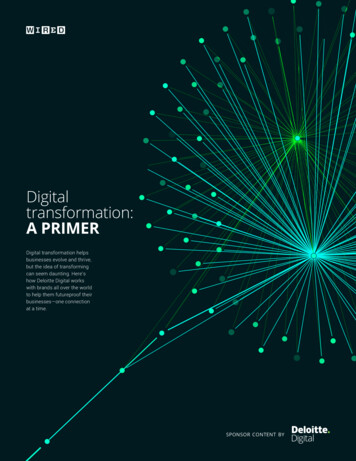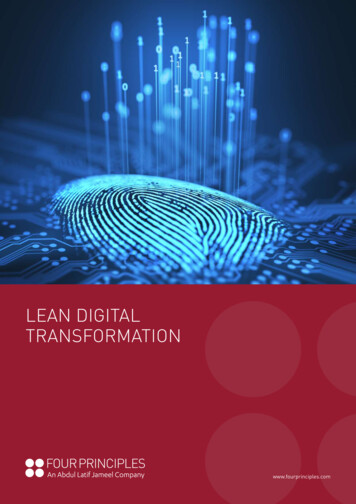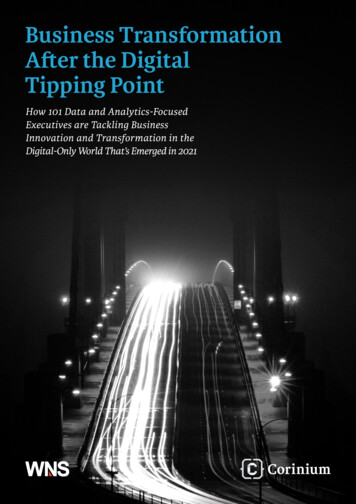
Transcription
Business TransformationAfter the DigitalTipping PointHow 101 Data and Analytics-FocusedExecutives are Tackling BusinessInnovation and Transformation in theDigital-Only World That’s Emerged in 2021
Business Transformation After the Digital Tipping PointContentsClick below to navigate3611151924Foreword4ExecutiveSummary7How the WorldWent Digital-Onlyin 2020Digital-OnlyProcesses are the‘New Normal’12Emerging DigitallyEnabled BusinessModelsSkill Enablement isEssential for DigitalTransformation Success16Laying theFoundation for aDigital-Only World20What’s Next forEnterprise DigitalTransformationMethodologyThe State of DigitalTransformation in 2021Conclusion2
Business Transformation After the Digital Tipping PointForewordNo other crisis in recent years has caused such large-scaledisruption. COVID-19 spared no industry nor region and,as companies grappled with the sudden turn of eventsglobally, we saw an accelerated shift to digital. Global enterprisesbegan to expand and fast-track their digital transformation efforts.This has made them better equipped than ever to streamlineoperations and drive enhanced customer experience (CX) with thelatest digital technologies.WNS partnered with Corinium Intelligence to survey 100 globalcompanies, and assess the state of digital transformation acrosseight industries along various parameters.While our research highlights the progress that has been made inmany areas, it also reveals the opportunities that are likely to shapethe digital transformation initiatives that will dominate the landscapein the months ahead. It spotlights the steps that enterprises aretaking to transform themselves using digital technologies and thechallenges they are encountering on this journey.Our research suggests that many executives believe intelligent,enterprise-wide automation is the key to accelerating digitalprocesses in today’s rapidly evolving environment. Technologiessuch as robotic process automation (RPA), intelligent automation,artificial intelligence (AI), low-code/no-code data integrationsoftware and blockchain have emerged as key investmentpriorities in 2021 and beyond.I believe that hyperautomation — the logical progression fromRPA and intelligent automation — can enable enterprises tounlock higher value from their digital investments. Domain-ledhyperautomation brings together intelligent automation, AI, RPAand data and analytics across disparate processes, technologies,applications, data silos and teams to orchestrate strategic digitaltransformation. It can simplify operations, build scalability andcreate seamless integrated CX.Enterprises that harness the power of these digital technologiesin their transformation journeys will be best placed to succeed inthe evolving normal.This report, with all its key findings, is essential reading for anydigital transformation leader.Adrian McKnightEVP, Business Transformation Group,WNS3
Business Transformation After the Digital Tipping PointExecutive SummaryThe business world changedforever in 2020. Digitaltransformations that wouldhave taken years were fast-trackedwhen COVID-19 forced a globaltransition to remote workingand largely digital commerce.The resulting shift in customerexpectations means the world willnever be the same again.leveraging social media analytics tobenchmark social media mentionsand consumer sentiment.This representative survey of 101digital transformation leaders inthe US, Europe and Australia —conducted by WNS and CoriniumIntelligence — highlights the impactcrossing this digital ‘tipping point’has had on the future of business.Just 1% of respondents say theirenterprises have automatedprocesses in place to streamlinetheir data governance practicesand ensure staff can fulfill theirroles comfortably. Meanwhile,77% say a lack of understandingof the risks involved whenadopting new technologies iscreating cybersecurity challengesfor their organizations.Our findings show that the pandemicdid more than accelerate digitaltransformations across the globe.Flexible or remote working modelsand a focus on digital processes andexperiences will remain the normlong after the world has gone backto normal.All the executives we surveyed arecommitted to improving businessprocesses with AI and analytics. Infact, 100% say their enterprises areusing AI models in production andBut despite these investments,many enterprises still lack the datagovernance and cybersecurityfoundations required to get themost out of cutting-edge digitaltechnologies.A full 73% of respondents expectto have completed all the digitaltransformations our researchtouches on within five years. Butgreater investment in the right‘data foundations’ will be requiredto ensure these projects deliveron their potential and drive returnon investment without exposingbusinesses to unnecessary risks.4
Business Transformation After the Digital Tipping PointKey Findings100%90%of respondents plan to adopta remote or partially remoteworking model permanentlyof enterprises that didn’taccelerate their digitaltransformations in responseto COVID-19 lost businessas a result97%76%have started deliveringtheir digital transformationstrategies and 28% saydigital is now part of theircompanies’ DNAsay a lack of executivesupport for cybersecurityimprovements is creatingchallenges for their digitaltransformation projects52%1%cite CX optimization asa ‘high priority’ strategicobjective for the next12 monthssay their organizationshave automated processesin place to streamline theirdata governance practicesSource: Corinium Intelligence, 20215
Business Transformation After the Digital Tipping PointMethodologyThis representative globalsurvey of 101 digitaltransformation leaders wasconducted in April and May 2021.Of these, 50% were from NorthAmerica, 40% were from Europeand 10% worked in Australia.Respondents were selectedfrom global enterprises with atleast 500 million USD in annualrevenues. They are all responsiblefor digital transformation initiativesin their enterprises and have jobtitles ranging from C-level (50%) toheads of department (40%) and VProles (10%).Their enterprises operate inthe insurance (20%), bankingand financial services (10%), lifesciences (20%), healthcare (10%),technology (10%), retail (15%), travel(10%) and shipping and logistics(5%) sectors.We asked respondents 16questions about their organizations’digital transformation strategies.Then, we combined our findingswith commentary from 10 industryexperts to put these insights intocontext and convey the true state ofglobal digital transformation projectsin 2021.ContributorsGabriele Compostella PhDCTO, VolkswagenData LabVipul ParmarGlobal Head of DataManagement, WPPEl DiawlolDirector of AdvancedAnalytics, Genesis Capital– Goldman SachsDan PowerMD, Data Governance,Global Markets,State StreetZeb DrummondGateway Bank, Head ofCustomer OperationsNino OcampoGlobal Head of OpenBanking and CustomerPreferences, HSBCLauren HeyndrickxCISO, Ralph LaurenSid ShahGlobal Head of Analyticsand Insight, Condé NastAdrian McKnightEVP BusinessTransformation Group,WNSKatia Walsh PhDChief Global Strategyand AI Officer, LeviStrauss & Co6
Business Transformation After the Digital Tipping PointHow the World WentDigital-Only in 2020KEY FINDINGCOVID-19 did more than acceleratedigital transformations across the globe.It catalyzed a fundamental shift in howenterprises do businessThe legacy of COVID-19 on businesses will be aboutmore than Zoom meetings and remote working.This pandemic has catalyzed a fundamental andpermanent shift in the way people do business.From shifts in consumer preferences in the car andproperty sectors to the transition of IT architectures tothe cloud and infusion of AI into back-office processes,enterprise leaders say there is no going back when itcomes to the changes wrought by the crisis.Our latest survey of 100 global digital transformationleaders shows that enterprises that were slow to pivottheir plans as lockdowns and other restrictions disruptedtheir operations paid a heavy price.More than a quarter of those who failed to adapt intime are struggling to survive, and just under 1% havegone bust. Another 37% lost a lot of business, while 27%lost some business. Only 10% of those who didn’t reactswiftly to the crisis saw no negative impact as a result.“There’s been a lot of focus on helping those who arenot digital to adopt digital,” says Nino Ocampo, GlobalHead of Open Banking and Customer Preferences atHSBC. “We see this as an opportunity for us to focus onsimplifying access to our digital features and improvingdigital engagement capabilities.”Many companies, especially the likes of Amazon, havethrived in the new online-only business environment. Butas enterprises start to re-imagine what their businesseswill look like in a post-pandemic world, the big questionis: How many of these pandemic-era innovations arehere to stay?“ We see this as anopportunity for us tofocus on simplifying accessto our digital featuresand improving digitalengagement capabilities”Nino OcampoGlobal Head of Open Bankingand Customer Preferences, HSBC7
Business Transformation After the Digital Tipping PointCOVID-19 Accelerated DigitalTransformation TrendsTransitioning to ‘digital only’has come naturally for someand brought big benefits. Someenterprises that used the pandemicto speed up a range of digitaltransformation initiatives arereporting that they are now fiveyears ahead of where they wouldotherwise be.“One of our biggest achievementsfor the last 12 months is being100% in the cloud,” says El Diawlol,Director of Advanced Analyticsat commercial lending platformGenesis Capital. “All our models aredeployed in the cloud and we’reable to manage the team remotely.At the beginning, that was a littlebit challenging. But for the last sixmonths, everything is stabilizing.”Many others have made similarprogress. Some 30% say thepandemic has accelerated themigration of data, applications andservices to the cloud by a year. Justover 17% are two years ahead, whilemore than 40% are 3-4 years aheadof where they would otherwise be.Progress in the automation ofback-office business processeshas been more profound: 97% ofBeing Digital Native is Vital inToday’s Business LandscapeIn your sector, what has happened to companies that were slow to adapt tothe new digital-only business landscape COVID-19 has catalyzed?1037%No negativeimpact%They have lost a greatdeal of business27%They have lostsome business1%They havegone outof business26%They are strugglingto surviveSource: Corinium Intelligence, 2021respondents say they are nowahead of schedule on this front, with35% shaving at least three years offtheir timetables.Client-facing processes wererapidly digitized, too. More than twothirds expedited things in this areaby up to two years, and a quarter“ One of our biggestachievements for thelast 12 months is being100% in the cloud”El DiawlolDirector of Advanced Analytics, Genesis Capitalaccelerated this transformation by3-4 years.These findings show thepandemic has primarily fast-trackedexisting industry trends, rather thanspawning new ones.In the automotive industry,the shift to working from homeand global restrictions on travelhave accelerated one disruptivetrend that could see consumersmove away from traditional carownership models.“For more and more people, theidea of owning a car is changing,”says Gabriele Compostella PhD,CTO at Volkswagen Data Lab.“This transformation relates tothe approach that people havetowards mobility, which I think hasbeen made even more dramatic orstrange by the pandemic.”8
Business Transformation After the Digital Tipping PointData Integrity is EnablingAnalytics SuccessThere is widespread acceptancethat the events of the past twoyears have changed how globalenterprises operate forever. None ofthe executives we surveyed expectto resume business as usual after thepandemic is over.A full 52% of respondents plan tomaintain their new online presencewhile restoring pre-pandemic,in-person operations, while 15%say they will slim down their inperson operations and continue toprioritize digital.The remaining third will aimto maintain their new onlinepresence while growing their inperson operations beyond prepandemic levels.“What we’re seeing from a trendperspective is certainly customers“ People are much more comfortablein digital mediums, wherepreviously they might’veapproached us in our branch orhave called us on the phone”Zeb DrummondHead of Customer Operations, Gateway Bankpandemic-era innovation that willleave a permanent mark on thebusiness landscape.Nobody we spoke to plans toresume 100% office-based working,while 40% say they will offer flexibilityto employees to work from homewhile maintaining mostly office-basedwork. Another 40% will introducehybrid models that blend remoteworking with a presence in the office.moving away from the traditionalbanking methods,” says ZebDrummond, Gateway Bank’s Headof Customer Operations. “Peopleare much more comfortable indigital mediums, where previouslythey might’ve approached us inour branch or have called us onthe phone.”The rise of flexible working isanother concrete example of aCOVID-19 Accelerated Enterprise Automation ProjectsPlease rate the impact the events of the past 12-18 months have hadon your organization’s attempts to automate back-office processesAccelerated by 4 yearsAccelerated by 3 yearsAccelerated by 2 yearsAccelerated by 1 year0%20%40%60%0%20%40%60%No positive impact80%100%80%100%Hi-Tech or Digital Native CompaniesInsuranceTravelBanking and Financial ServicesRetailLife Sciences (Pharmaceutical)HealthcareShipping and LogisticsSource: Corinium Intelligence, 20219
Business Transformation After the Digital Tipping PointThe rest will do away with officesaltogether and go 100% remote.“When COVID-19 hit first, manyorganizations were shocked,” Diawlolsays. “They were actually thinking,‘How are we going to operatein this environment?’ [But] manyorganizations were very surprisedto see that most of their operationsstayed operational. In terms ofproductivity, there wasn’t a lot of loss.”All this means it has neverbeen more important for globalenterprises to invest in digitaltransformation. The innovations thathave helped businesses survivethese trying times will continue todrive efficiency and productivitygains in the post-pandemic world.While in-person meetings andinteractions will no doubt return inthe coming months, the era ofdigital-only is here to stay. In thisnew era, businesses that failto phase out outdated analogprocesses will struggle to survive.Digital will Remain a Key Priority After the PandemicWhich of the following statement best describes how your business will operatein the post-pandemic ‘new normal’?0%We will resume100% office-basedworking40%We will return tolargely office-basedwork, but withgreater work-fromhome flexibility20%We will operate a 100%remote working model40%We will operate ahybrid model thatblends office-basedwork with regularremote workingSource: Corinium Intelligence, 202110
Business Transformation After the Digital Tipping PointDigital-Only Processesare the ‘New Normal’KEY FINDINGEnterprises accelerated their digital transformations following the pandemicand intend to make digital a core part of their businesses going forwardDigital will Remain a Key Priority After the PandemicExecutives are Committedto Digital TransformationWhich of the following statement best describes how your businesswill operate in the post-pandemic ‘new normal’?0%Which of the following best describes yourorganization’s top-down attitudes towardsdigital transformation investments?33%We will resumeour pre-pandemic‘business as usual’We will maintain our newpresence online, whilegrowing our in-personoperations to beyondpre-pandemic levels14%We have substantially expanded ourdigital transformation investmentplans following the pandemic50%15%We have slightly expandedour digital transformationinvestment plans followingthe pandemic52%We will operate ‘slimmeddown’ in-person operationsand continue to prioritizedigital channels37%We will restore ourpre-pandemic in-personoperations, while maintainingour new presence onlineWe were already fully committedto digital transformation beforethe pandemicThe Pandemic Accelerated Global Digital TransformationsPlease rate the impact the events of the past 12-18 months have had on the following types of digital transformation in your organizationAccelerated by 5 yearsAccelerated by 4 yearsAccelerated by 3 yearsAccelerated by 2 yearsAccelerated by 1 yearNo positive ng client-facing business processesOptimizing back-office business processesDigitizing back-office business processesAutomating client-facing business processesMigrating data, apps and services to the cloudDigitizing client-facing business processesAutomating back-office business processesSource: Corinium Intelligence, 202111
Business Transformation After the Digital Tipping PointEmerging DigitallyEnabled Business ModelsKEY FINDINGAll large enterprisesare advancing theirdigital transformationagendas to develop newAI and analytics-poweredtools, capabilities andbusiness models‘Digital transformation’ is aconcept that’s constantlyevolving. No company’sdigital transformation is ever trulycomplete, because the businesscommunity is constantly innovatingwith new technologies.For decades, enterpriseshave been working to digitalizebusiness processes and harnessthe power of data to drive revenueand efficiency savings. So, it’sno surprise that 99% of the 100executives we surveyed say theircompanies are committed to digitaltransformation.In fact, 28% say digital is nowpart of their companies’ DNAand they’re taking advantage ofnew opportunities as they arise.Meanwhile, 40% say they havemade their key investments and areprioritizing change managementand adoption. The remaining 30%say they are scaling up their firstsuccessful digital transformationproject pilots or experiments.“Even before the pandemic, themedia was going through the journeyof migrating or moving users froman offline or a print environment to amore digital environment,” says SidShah, Global Head of Analytics andInsight at media giant Condé Nast.“The pandemic has just acceleratedthis [shift].”“One of the catalysts is that theynever had this type of data before,”he adds. “When you look at digital,you have an array of data you can tapinto and understand the needs andthe demands of the consumer.”“ Executives in themedia are moredigitally awarethan any otherindustry, becausetheir entire ecosystemnow is digital”Sid ShahGlobal Head of Analyticsand Insight, Condé Nast12
Business Transformation After the Digital Tipping PointMany Transformation Projectsare Already CompleteOur research shows that manyexecutives feel their enterpriseshave already completed a rangeof digital transformations. What’smore, some of the executives wespoke to say this is at least in partdown to the business landscape thepandemic created.A full 53% of our surveyrespondents say they havedigitized their client-facing businessprocesses, 48% say they havefinished migrating data, applicationsand services to the cloud and 42%say they have finished digitizingtheir back-office processes.“Enterprises have been movingtoward these digital business anddigital operating models for sometime,” says Adrian McKnight, EVP,Business Transformation Group atWNS, a global business process“ Enterprises have been moving towardthese digital business and digitaloperating models for some time.But the pandemic accelerated thisevolution dramatically”Adrian McKnightEVP, Business Transformation Group, WNSmanagement company. “But thepandemic has accelerated thisevolution dramatically.”However, fewer respondents feelthey are getting the most out ofdigital technologies when it comesto optimizing business processes.Just 38% report that they have nowoptimized all client-facing businessprocesses and 33% say the sameabout their back-office processes.Most Client-Facing Business Processes are Digital NowPlease indicate when you believe your organization will finish digitizing itsclient-facing business processesAlready completedWithin 1-2 years0%Within 2-5 years20%40%More than 5 years60%80%100%HealthcareRetailTravelInsuranceLife Sciences (Pharmaceutical)Banking and Financial ServicesHi-Tech or Digital Native CompaniesShipping and LogisticsSource: Corinium Intelligence, 2021For example, Shah says thatthe media industry’s evolutionfrom advertising-based businessmodels to subscription-basedones is ongoing. Meanwhile, manycompanies are exploring new waysto harness analytics to serve peoplewith highly personalized content.“While it was just hype a fewyears ago, more and more peopledo grasp the importance ofdata analytics,” agrees GabrieleCompostella PhD, CTO, atVolkswagen Data Lab. “People dounderstand perfectly what kind ofautomation they can have.”Our research tells a similar storywhen it comes to automating businessprocesses using technologies suchas AI or RPA. Among our surveyrespondents, 29% and 21% saythey’ve finished automating theirback-office and client-facingbusiness processes, respectively.This may prove to be a focalpoint for companies in the yearsahead, as digital transformationleaders look to integrate intelligentautomation, RPA, AI and analyticsthrough hyperautomation toreimagine enterprise-wide businessprocesses. For WNS, domain-ledhyperautomation is key to drivingsuccessful transformations.13
Business Transformation After the Digital Tipping PointAnalytics and AI in theModern EnterpriseIn the past, digital transformationprojects revolved around usinghistorical data to analyze trends.But in 2021, enterprises are focusingon harnessing the power of datain near-real-time for use in AI oranalytical initiatives.All the executives we surveyedsay their enterprises have deployedAI systems and are using them inproduction. Of these, 28% havestarted scaling AI models across theirorganizations and 24% say they haveembedded AI systems fully into theirbusiness processes.“We’re climbing quite swiftly up thatmaturity curve,” says Vipul Parmar,Global Head of Data Managementat advertising giant WPP. “First andforemost, it’s with the lens of drivingefficiency, but also intelligence.”At the same time, social mediaanalytics has emerged as a ‘musthave’ for the modern enterprise,with 100% of survey respondentssaying they use social listening toolsregularly to benchmark social mediamentions and consumer sentiment.“For media folks, social media is notjust another channel to support andbe present on,” notes Shah. “This isan important strategic tool, and also arevenue-generating tool.”Enterprises in All Sectors Use Social AnalyticsWhich of the following statements best describes your organization’scurrent level of social media analytics maturity?INTERMEDIATEwe use social listeningtools on a regular basis,to benchmark social mediamentions and consumersentiment online and trackthese metrics over timeEXPERTin addition to augmentingmanual processes withsocial media insights,we use social analyticsdata to feed predictiveor althcareTravelInsuranceHi-Tech or Digital Native CompaniesRetailBanking and Financial ServicesLife Sciences (Pharmaceutical)Shipping and LogisticsSource: Corinium Intelligence, 2021“Social media listening tools helpmedia companies understand theiraudiences, so they can preparebetter and more relevant content,” hecontinues. “They also help to createa narrative understanding of theiraudience personas.”“ More and more people do grasp theimportance of data analytics. Peopledo understand perfectly what kindof automation they can have”Gabriele Compostella PhDCTO, Volkswagen Data LabADVANCEDwe have integrated regularsocial analytics reports withmanual business processes,so client-facing staff canreact to social mediamentions intelligentlyNearly half of respondents (48%)say they have integrated regularsocial analytics reports with manualbusiness processes, so staff can reactto social media mentions intelligently.What’s more, 11% say they are usingsocial analytics data to feed predictiveor prescriptive analytical models.These findings highlight the crucialrole analytics and AI technologies arelikely to play in the future of business.Everyone we spoke to istransforming their operations tobake AI and advanced analyticsinto business processes. If thistrend continues, hyperautomation,analytics and AI-powered businessmodels will become ubiquitous in thecoming years.14
Business Transformation After the Digital Tipping PointStaff Enablement isEssential for DigitalTransformation SuccessEnterprises are Investingin Digital EnablementWhich of the following steps is yourorganization taking to ensure staffhave the skills they need to workwith data-driven technologies?We’ve done this alreadyWe will do this in 2021KEY FINDINGWe have no plans to do this yet1%77%22%Enterprises are investing in ensuring executives understandthe technologies driving their digital transformationsand staff have the skills to get the most out of themProvided dataliteracy trainingto executivesDigital Transformation Projects Face Many ChallengesWhich of the following steps is your organization taking to ensure staff have the skillsthey need to work with data-driven technologies?Strongly AgreeAgreeDisagreeNeither Agree nor Disagree0%20%40%60%Strongly Disagree80%100%55%5%1We have the skills and talent to deliverour digital transformation plansLaunchedcompany-widedata literacyprogramsOur digital transformation plansenjoy company-wide supportStaff have the skills they need towork effectively with digital tools0%3We have the right processesto manage models in productionWe have the infrastructure to developand deploy digital capabilities efficiently45%We have invested sufficientlyin change managementWe have executive sponsorship forour digital transformation plans0%20%40%60%80%Providedtraining in ‘softskills’ to datafocused staff100%37%18%New Technologies are Helping to Meet These ChallengesWhich of the following steps is your organization taking to ensure staff have the skillsthey need to work with data-driven technologies?0%10%20%30%16%40%Hired ‘datatranslators’AI-powered chatbots / Conversational AIBlockchainAI or machine learning models50Digital Twin technologyOmnichannel communications platformsInternet of Things (IoT)34%Data integration technology%16%Data visualization platformsLinked staffKPIs todata-drivenmetricsCloudAugmented intelligence decisioning toolsRobotic Process Automation (RPA)42%Edge computing42%CRM tooling0%10%20%30%40%Source: Corinium Intelligence, 202115
Business Transformation After the Digital Tipping PointLaying theFoundationfor a DigitalOnly WorldKEY FINDINGMany enterprises still lack the strongdata governance and cybersecurityfoundations necessary for successwith cutting-edge digital technologiesDigital transformation enables enterprises tospeed up processes, improve CX and stayahead of the competition. However, makingthese changes successfully depends on having theright governance, compliance and security practices inplace to manage the risks.Katia Walsh PhD, Chief Global Strategy and AI Officerat Levi Strauss & Co, says this is only possible whencompanies have the right ‘data foundation’.“[Data] is the essence of a company’s digitaltransformation,” she says. “You cannot separate datafrom digital and you cannot separate data from AI.”“Data is the underpinning element that drives digitaltransformation,” agrees Adrian McKnight, EVP, BusinessTransformation Group at WNS. “Creating the rightsecurity environment and the ability, therefore, to avoidcybersecurity problems is absolutely critical, as well.”Despite their eagerness to embrace the latest AI anddata-driven technologies, and replace outdated analogprocesses, our research shows that many enterprisesstill lack the strong data governance and cybersecurityfoundation necessary for success.“ You cannot separatedata from digital andyou cannot separatedata from AI”Katia Walsh PhDChief Global Strategy and AI Officer,Levi Strauss & Co16
Business Transformation After the Digital Tipping PointData Governance is a DigitalTransformation BottleneckData governance encompasseseverything from data qualitymanagement to data lineage,compliance, privacy and securityand access controls. In short, it’svirtually everything a companymust do to ensure the data feedinginto business processes is fitfor purpose.Of the 100 people we surveyed,1% say their organizations haveautomated processes in place tostreamline their data governancepractices and ensure staff can fulfiltheir roles comfortably.A further 45% say data projectsin their enterprises follow datagovernance guidelines andprinciples but add that manualprocesses mean this can oftenbe labor-intensive. In the bankingand financial services sector,64% of respondents reportthis ‘intermediate’ level of datagovernance maturity.“The biggest killer of datagovernance programs is lack ofautomation,” says Dan Power, MD,Data Governance, Global Marketsat financial services giant StateStreet. “More automation throughbetter AI and machine learningFew Enterprises Have Mature Data Governance FunctionsWhich of the following statements best describes your organization’s currentlevel of data governance maturity?4%BEGINNERExecutives recognizethe importance of datagovernance, but we lack aframework and processesto ensure good datagovernance51%INTERMEDIATEOur core data governanceframework is in place, but westruggle with data silos and alack of awareness of individualdata governance responsibilities1%EXPERTWe have automatedprocesses in place tostreamline our datagovernance practices andensure staff can fulfil theirroles comfortably44%ADVANCEDAll projects follow datagovernance guidelines andprinciples, but manual processesmean this can be labor-intensiveSource: Corinium Intelligence, 2021capabilities in data quality toolswould be a huge help.”Just over half of resp
Tipping Point. Contents 3 Foreword 7 How the World Went Digital-Only in 2020 12 16 20 Emerging Digitally Enabled Business Models Laying the Foundation for a Digital-Only World What's Next for Enterprise Digital Transformation Click below to navigate 4 Executive Summary 11 Digital-Only




